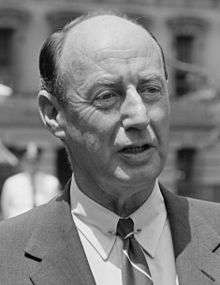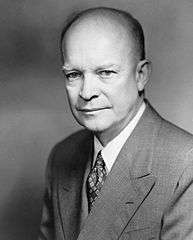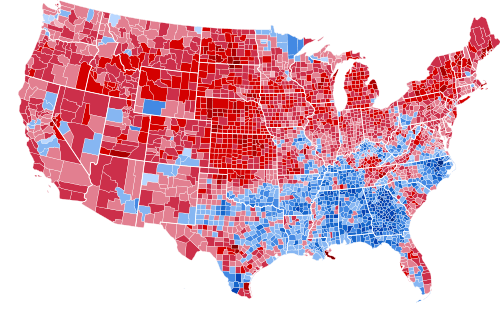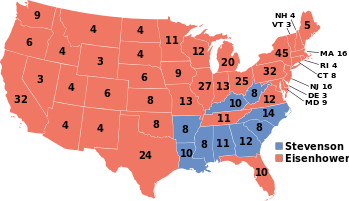United States presidential election in Mississippi, 1952
| | ||||||||||||||||||||||||||||||||
| ||||||||||||||||||||||||||||||||
| ||||||||||||||||||||||||||||||||
|
| ||||||||||||||||||||||||||||||||
| County Results
Stevenson—>90%
Stevenson—80-90%
Stevenson—70-80%
Stevenson—60-70%
Stevenson—50-60%
Stevenson—<50%
Eisenhower—<50%
Eisenhower—50-60%
Eisenhower—60-70%
Eisenhower—70-80%
Eisenhower—80-90%
Eisenhower—>90% | ||||||||||||||||||||||||||||||||
| ||||||||||||||||||||||||||||||||
The 1952 United States presidential election in Mississippi took place on November 4, 1952 as part of the United States presidential election of 1952.
The Democratic Party candidate, Governor Adlai Stevenson of Illinois, won the state of Mississippi over Republican Dwight D. Eisenhower, the former Supreme Allied Commander Europe and General of the Army by a margin of 59,600 votes, or 20.88%. Eisenhower went on to win the election nationally, with 442 electoral votes and a commanding 10.9% lead over Stevenson in the popular vote.
Incumbent President Harry S. Truman was the last President who was unaffected by the term limit imposed under the 22nd Amendment, but decided as early as 1950 that he would not seek another term. Illinois governor Adlai Stevenson II, son of former Vice President Adlai Stevenson I, accepted the Democratic nomination for president in Truman's place, selecting Alabama Senator John Sparkman, a Southern Democrat, as his running mate.
Analysis
Mississippi in this time period was a one-party state dominated by the Democratic Party. The Republican Party was virtually nonexistent as a result of disenfranchisement among poor whites and African Americans, including voter intimidation against those who refused to vote Democrat. The 1948 election had split the National Democratic Party and segregationist Democrats over the issue of civil rights for African Americans. In the 1952 election, Stevenson, a moderate on race issues, selected the segregationist Senator Sparkman as his running mate to avoid another split in the Democratic vote.
Results
The Stevenson-Sparkman ticket carried Mississippi and its 8 electoral votes in a landslide against the Eisenhower-Nixon ticket with 60.44% of the popular vote, amounting to a total of 172,566 votes.[1] These results, however, were the weakest for a Democrat since Grover Cleveland in the 1884 election, when he won 64.34% of the vote in Mississippi. Eisenhower's total of 112,966 votes, or 39.56%, was the strongest performance in Mississippi since the 1884 election, surpassing James G. Blaine's percentage of 35.66%. This represented a large swing for the Republicans from 1948, when Thomas E. Dewey won only 2.62% of the vote.
Stevenson carried 67 of Mississippi's 82 counties, running up huge margins in the northeastern corner and rural areas of the state. Eisenhower carried 15 counties, the first time a Republican had carried any since Herbert Hoover in 1928. His main base of support came from the western counties along the Mississippi River, which had a high concentration of African Americans, including Hinds County, home to the state capital Jackson. 3 counties in particular, Sharkey, Forrest, and Lowndes, gave Eisenhower over 60% of the vote.
1952 began to show signs of the impending collapse of Democratic dominance in Mississippi and the rest of the South. The percentage of victory for the Democratic candidate would decline in the next two subsequent elections, ultimately paving the way for Barry Goldwater's victory in Mississippi and the Deep South in 1964.
References
- ↑ Leip, David. "Dave Leip's Atlas of U.S. Presidential Elections". uselectionatlas.org. Retrieved 2016-10-21.



